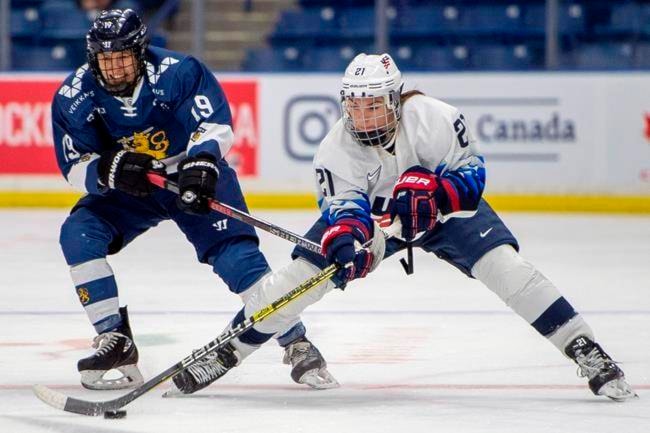Prominent members of the U.S. women’s hockey team moving to Canada to play strengthens speculation that a merger of the top two women’s leagues into one is nigh.
Hilary Knight, Brianna Decker and Kacey Bellamy say their decisions to play in the Canadian Women’s Hockey League this season were personal, not collective.
But they’re also not adverse to their relocations strengthening the winds of change blowing through women’s hockey.
Both interim CWHL commissioner Jayna Hefford and NWHL commissioner Dani Rylan indicated this year a merger is desirable.
Knight now plays for the Les Canadiennes de Montreal. Decker, Bellamy and goaltender Alex Rigsby joined the Calgary Inferno this season.
All four were members of the team that beat Canada in a shootout for Olympic gold in February.
When defender Megan Bozek was released from the U.S. Olympic squad midway through last winter, she joined the Markham Thunder and remained with the team this season.
The five women previously played in the NWHL when it began in 2015.
“It’s all of our goals to form this one league because we have so many talented players in both leagues,” Bellamy said in Saskatoon at the Four Nations Cup tournament.
“Honestly, I just think for us going to Calgary, Hilary went to Montreal and Megan went to Markham, it’s the situations we wanted to be in.”
So high-profile players from Canada and the U.S., who battled each other tooth and nail for Olympic gold in Pyeongchang, South Korea a few months ago, are adjusting to each other as teammates.
Knight in Montreal gives Les Canadiennes arguably two of the best players in the world with Canadian captain Marie-Philip Poulin also on the roster.
“You have the chance to play against each other at the highest international level and now we have the chance to play a whole season together,” Poulin said. “We can make each other better. We can push each other to the next level.
“Obviously there’s mutual respect there in how much we want to grow women’s hockey and that’s how it all starts, playing all together in the same league.”
Canadian forwards Rebecca Johnston and Brianne Jenner now have Decker, Bellamy and Rigsby in the Inferno dressing room with them.
“I’ve played against those players for a long time so it’s kind of nice to be on the other side and get to know them as people,” Jenner said. “When you’re on the ice against them, you forget they’re people.
“I think we all want the best players playing in one league. How that looks is still to be seen. When you’re competitive, you want to play with and against the best.”
The six-team CWHL is in its 12th season. The NWHL has five U.S.-based teams.
The pay in both the CWHL and NWHL remains nominal compared to men’s pro leagues, so choosing club colours can come down to personal preference.
Edmonton’s Shannon Szabados became the first player from the Canadian women’s team in the NWHL when the goaltender signed with the Buffalo Beauts this season.
She moved to the Ohio hometown of her partner Carl Nielsen and Buffalo is within commuting distance.
Knight, Decker and Bellamy said getting to play two games a weekend instead of one, and simply a change of scenery in the first season of the Olympic quadrennial, were factors in switching from the NWHL to the CWHL.
“We want one league. I don’t think our decision ended up being that reason,” Decker said. “That’s our goal though. We want one supported league. That’s how we’re going to be able to sustain having fans.”
Knight indicated there was another layer to her decision, however.
“When you’re thinking about the future of the game, I think the CWHL has guarded it the best in terms of a player standpoint,” she said.
The U.S. women threatening to boycott the 2017 world championship in Michigan and wresting increased financial and competitive benefits from USA Hockey was a lesson in collective bargaining for the women’s hockey community.
“What we’ve gotten out of that is the empowerment in ourselves and the power we hold as players collectively to build the future of women’s hockey at the pro level,” Knight said.
“I think there’s a lot of changes to come. I wouldn’t be surprised in a year or two if things are different.”
Donna Spencer, The Canadian Press
